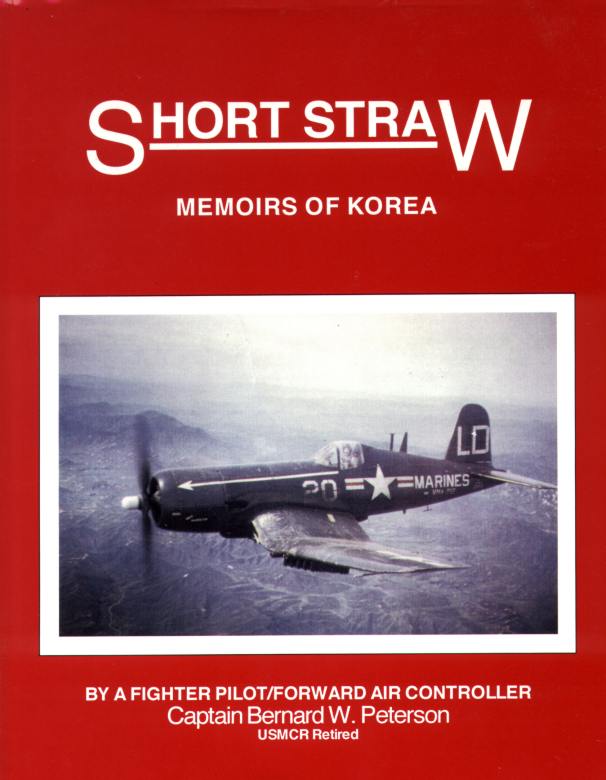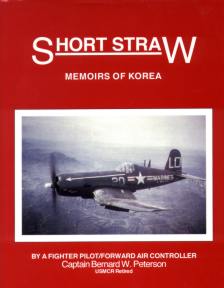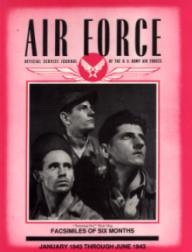This book does not attempt to cover the Korean War in all its aspects. It is simply Captain Bernard W. Peterson's own reflection of his personal experience. If his story adds just one small facet to the factual history of the intensive actions in that conflict carried out by all-American combat units and their UN allies, and if it stimulates additional investigation by historians, it will have achieved its primary aim. Short Straw, then, is Peterson's sequel to his first book, Briny to the Blue, Memoirs of WWII, by a Sailor/Marine Fighter Pilot.
I am not a professional writer, nor a historian for that matter, but just one ex-Marine among thousands who wants to tell of this small part during a tragic and dramatic period of our country's history. Numerous books on the Korean War have been written by professional historians who have only gleaned their stories from active participants rather than relating their own firsthand experience, probably lacking in many cases. It is therefore, my intention to preserve as many of my firsthand, on-the-spot personal accounts as possible, and to try to put the reader right there beside me, whether it be in the cockpit of my F4U Corsair or in a slit trench with the 1st Marine Division calling in air strikes. Army, Navy and U.S. Air Forces are covered in the book.
The Korean War commands little more than a footnote in history books, when in fact it was a long drawn-out campaign during which nearly six million men and women served in the armed forces under the United Nations banner, fighting three times as long as they did in World War I, "the war to end all wars." Actually, the war in Korea lasted almost as long as WWII and ironically, all of Korea, China and Russia had been our allies back then and Japan our common enemy. Talk about reversals and the vagaries of politics! The purpose of our entrance into this conflict was to rescue the newly established Republic of Korea (ROK) from the invading communist hordes, first the North Koreans and then the Chinese communists all marching to the drum-beat of Joe Stalin's International Communism.
It all began with our peaceful ally, South Korea, being attacked by its neighbors to the north. This was unprovoked, raw aggression, first by the North Koreans and then by massive Chinese armies. Unfortunately, nobody had really explained to us why we were expected to fight, and, yes, die for an Asian country of which most of us had never heard. However, a defeat would have been a national disgrace and Japan, not yet recovered from WWII, would have fallen next.
In the final analysis, Korean vets can stand tall and be proud in spite of all the old cliches, such as "The Forgotten War," "Uncertain Victory" etc, even though there were no welcome home marching bands or Keys-to-the-City handed out. The satisfaction of having been part of a united effort to stop communism wherever it threatened the free world is enough.
A thousand volumes could not begin to portray the chaos, drama, meanness, frenzy and cold terror that took place over the three years of fighting, which resulted in nearly the same number of deaths as the Vietnam War did over a 10 year period. The number of Americans killed during the Korean War was 54,246. Approximately 92,970 UN troops had fallen into communist hands -- 7140 of them Americans, 84,715 Korean, and some 1115 members of other UN units. The communists admitted to holding only 11,500 UN POWs. Two-thirds of them --Americans held in communist prison camps-- were destined never to return. I can only hope my book will provide a fresh insight to this devastating military exercise.
Most military planners and historians are now looking back
and saying that the Korean War was the decisive action that
turned the tide of World Communism and will be so noted when the
ultimate definitive history is written. My book, then, will by
no means be the last word on the valor and heroism that was
shown by our American servicemen and women, as well as our
allies. The significance of this little "footnote in history"
may finally be understood.
From the Author
Captain Bernard W. Peterson, USMCR (Ret) was born in Long Beach,
CA, and joined the Navy February 1941, at age 17. After
attending boot camp and Aviation Machinist Mate School in San
Diego, he joined Torpedo Squadron Three (VT-3) aboard the USS
Saratoga. Following an abortive attempt to save Wake Island in
December 1941, shortly after the Japanese raid on Pearl Harbor,
the Saratoga was torpedoed by a Japanese submarine in January
1942. In late May, Torpedo Squadron Three boarded the USS
Yorktown and suffered heavy losses at Midway in June, losing all
twelve of their TBDs, 10 pilots and 11 rear-seat crewmen, with
the balance of the non-flying personnel swimming from the
sinking carrier.
With the TBF Grumman Avengers and new pilots, they boarded the USS Enterprise and took the Marines into Guadalcanal 7 August 1942, but after sustaining major damage from Japanese dive bombers 24 August during the Battle of Stewart Island, the ship returned to Pearl Harbor. Peterson sustained severe injuries during this battle.
January 1943 found VT-3 off the USS Saratoga briefly at Noumea, New Caledonia, where Peterson received his orders to flight school. Returning on the Lurline to San Francisco, he enrolled as an aviation cadet USNR (V5), receiving his Wings of Gold December 1943 at Corpus Christi, TX, and a 2nd Lieutenants commission in the USMCR. During the first half of 1944 he flew SBD-5 dive bombers in Miami, FL, and the second half F4U Corsairs at Congaree, South Carolina and at Cherry Point, NC, where he met and married Corporal Marion Gleason, USMCWR, from New Hampshire.
Peterson returned to the Pacific in December 1944, joining the Marine Fighter Squadron VMF-223 Bull Dogs in Bougainville. They soon departed for the Philippines, flying combat missions until June 1945, when they flew their Corsairs to Okinawa.
Following cessation of hostilities, he went on inactive duty. After attending Curtiss Wright Aeronautical Institute in Burbank, CA, he worked for AiResearch Manufacturing Co. until he volunteered for the Korean campaign in 1951. Following his retraining as a fighter pilot at Marine Corps Air Station at El Toro, CA, in VMF-232, he was sent to Korea where he flew F4U Corsairs with the VMF-212 Devil Cats, starting March 1952, logging 60 missions (the last 20 as flight leader), followed by a 5-month tour as a forward air controller on the front lines during the Battle of Bunker Hill, with the 3rd Bn, First Rgmt, First Marine Division.
Wounded in the trenches, Peterson soon returned to duty and served until November 1952, when his 17 months of active duty time ended. This completed his active and reserve duty with the Marines.
Capt. Peterson's service awards include: The Silver Star, three Distinguished Flying Crosses, 9 Air Medals, the Bronze Star with Combat "V", Navy Commendation Medal with Combat "V", the Purple Heart, American Defense, American Campaign, Asiatic Pacific, WWII Victory, National Defense, Korean Service Medal with two Bronze Stars, the United Nations Service Medal, Presidential Unit Commendation Ribbon with one Bronze Star, Philippine Liberation Ribbon with one Bronze Star, Republic of Korea Presidential Unit Citation, and the Philippine Presidential Unit Citation.
Peterson returned to this former civilian job with Ai Research/Garrett/Allied Signal Companies, retiring in Phoenix, AZ, in 1983 as a senior Project Engineer in the Gas Turbine Engine Division, following 37 years with the same company.
Peterson is still married to former Corporal Marion Gleason, who has given him two fine sons and two lovely daughters. They reside in Scottsdale, Arizona, Sonoran Desert, where they enjoy their nine grandchildren, swimming, golfing, RVing and attending military reunions.




